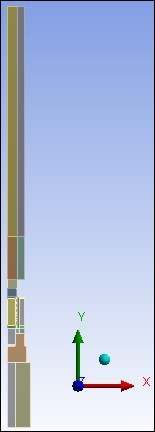The following figure shows the geometry of the threaded-connection model used in this example problem:
The analysis is a three-step process:
Step 1: Solve a 2-D axisymmetric threaded-connection model under internal pressure and end-cap loading.
Step 2: Convert the 2-D axisymmetric model to the full 3-D model.
Step 3: Continue the analysis on the 3-D threaded-connection model under bending load.
The geometry and loadings in the first step are axisymmetric, so the analysis begins with a 2-D axisymmetric model to solve for internal pressure and tensile loadings. Using a 2-D to 3-D analysis, the 2-D deformed mesh is extruded to a new 3-D mesh and solution results are mapped to the 3-D model. The analysis then continues with the 3-D model, on which a nonaxisymmetric (bending) load is applied.
Starting the threaded-connection analysis with a 2-D axisymmetric model rather than a 3-D model:
Requires significantly less computational time.
Reduces the likelihood of convergence issues when solving the 2-D model with contact pairs.



